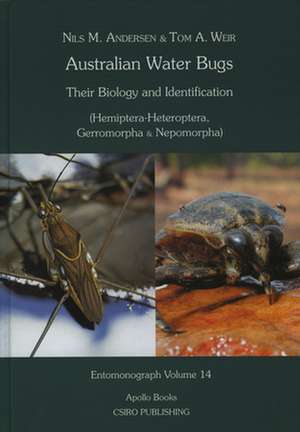Australian Water Bugs. (Hemiptera - Heteroptera, Gerromorpha & Nepomorpha): Their Biology and Identification: Entomonograph, cartea 14
Autor Nils Møller Andersen, Tom A. Weiren Limba Engleză Hardback – 31 dec 2003
Preț: 395.51 lei
Preț vechi: 465.31 lei
-15% Nou
Puncte Express: 593
Preț estimativ în valută:
75.69€ • 82.19$ • 63.58£
75.69€ • 82.19$ • 63.58£
Carte indisponibilă temporar
Doresc să fiu notificat când acest titlu va fi disponibil:
Se trimite...
Preluare comenzi: 021 569.72.76
Specificații
ISBN-13: 9788788757781
ISBN-10: 8788757781
Pagini: 344
Greutate: 0 kg
Editura: Brill
Colecția Brill
Seria Entomonograph
ISBN-10: 8788757781
Pagini: 344
Greutate: 0 kg
Editura: Brill
Colecția Brill
Seria Entomonograph
Descriere
Water bugs are familiar insects in aquatic habitats throughout the World. They belong to the order Hemiptera, the largest insect order with incomplete metamorphosis. There are basically two kinds:
(1) the semiaquatic bugs (Gerromorpha) which live upon the water surface, and
(2) the true water bugs (Nepomorpha) which live beneath the water surface.
Water bugs are found in a wide variety of natural habitats from small, temporary pools to larger ponds and lakes, from small streams to rivers, and from inland freshwater bodies to coastal mangroves, tidal pools of coral reefs, and the surface of the ocean. Water bugs are chiefly predators or scavengers, feeding on any prey they can master, from tiny crustaceans and insects to tadpoles and small fish. They play a major role in aquatic ecosystems and may serve as indicators of the biological quality of aquatic habitats. They are chiefly beneficial to man since many species prey on mosquitoes and are themselves preyed upon by fish. Because of their diverse lifestyles and because they are easily observed in their natural habitats, water bugs are excellent model organisms in evolutionary biology, ecology, and conservation biology.
This handbook is the first comprehensive guide facilitating the identification of Australian water bugs. It provides an overview on all 15 families, 17 subfamilies, and 55 genera known to occur on mainland Australia, Tasmania and nearby islands. Illustrated keys, featuring a minimum of technical language, are offered to assist with the identification of adult water bugs. For each genus, the handbook includes a description of the characters used to identify the genus and to separate the genus from similar genera, an illustration to show overall appearance (“habitus”) of a representative species, an illustrated key to species recorded from Australia, overview of the biology of the genus, and a map showing the locations where the genus has been found in Australia.
(1) the semiaquatic bugs (Gerromorpha) which live upon the water surface, and
(2) the true water bugs (Nepomorpha) which live beneath the water surface.
Water bugs are found in a wide variety of natural habitats from small, temporary pools to larger ponds and lakes, from small streams to rivers, and from inland freshwater bodies to coastal mangroves, tidal pools of coral reefs, and the surface of the ocean. Water bugs are chiefly predators or scavengers, feeding on any prey they can master, from tiny crustaceans and insects to tadpoles and small fish. They play a major role in aquatic ecosystems and may serve as indicators of the biological quality of aquatic habitats. They are chiefly beneficial to man since many species prey on mosquitoes and are themselves preyed upon by fish. Because of their diverse lifestyles and because they are easily observed in their natural habitats, water bugs are excellent model organisms in evolutionary biology, ecology, and conservation biology.
This handbook is the first comprehensive guide facilitating the identification of Australian water bugs. It provides an overview on all 15 families, 17 subfamilies, and 55 genera known to occur on mainland Australia, Tasmania and nearby islands. Illustrated keys, featuring a minimum of technical language, are offered to assist with the identification of adult water bugs. For each genus, the handbook includes a description of the characters used to identify the genus and to separate the genus from similar genera, an illustration to show overall appearance (“habitus”) of a representative species, an illustrated key to species recorded from Australia, overview of the biology of the genus, and a map showing the locations where the genus has been found in Australia.

